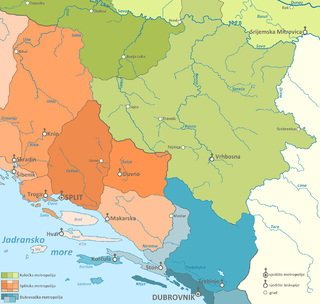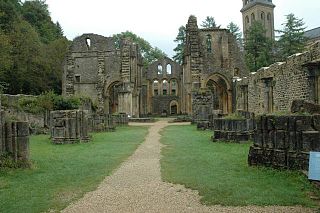
Tropolje was a historical Croatian duchy, which was located on the borderland of Croatia, Bosnia and Zachlumia. Its exact borders are disputed among historians.

Tropolje was a historical Croatian duchy, which was located on the borderland of Croatia, Bosnia and Zachlumia. Its exact borders are disputed among historians.
Vjekoslav Klaić thought that Tropolje encompassed the Cetinsko Polje, Livanjsko Polje and Duvanjsko Polje, and possible other poljes on the borderland of Croatia, Bosnia, and Zachlumia. Marko Perojević, on the other hand, argued that Tropolje included the Kosovo Polje (near Knin), Petrovo Polje (near Drniš) and Mućko Polje. Additionally, Dominik Mandić included Livanjsko Polje as well. Sima Ćirković held that Tropolje streched over Livanjsko Polje, Duvanjsko Polje and Glamočko Polje. [1] Krunoslav Draganović and Damir Karbić argued that Tropolje included Duvanjsko Polje, Kupreško Polje, and Glamočko Polje. Karbić, agreeing with Draganović, said that a document from 1301 supports his conclusion and that the northern borders thus defined, fitted the borders of the Diocese of Duvno. [2] The document from 1301, to which Karbić was referring, mentions the sons of Paul I Šubić of Bribir – Mladen, George and Paul, as "Duke of Tropolje, Livno and Cetina", who adopted the title on the verge of the 13th to 14th century after securing the territory of the eastern Adriatic hinterland. [2] [3]

Zachlumia or Zachumlia, also Hum, was a medieval principality located in the modern-day regions of Herzegovina and southern Dalmatia. In some periods it was a fully independent or semi-independent South Slavic principality. It maintained relations with various foreign and neighbouring powers and later was subjected to Kingdom of Hungary, Kingdom of Serbia, Kingdom of Bosnia, and at the end to the Ottoman Empire.

Tomislavgrad, also known by its former name Duvno, is a town and the seat of the Municipality of Tomislavgrad in Canton 10 of the Federation of Bosnia and Herzegovina, an entity of Bosnia and Herzegovina. As of 2013, it has a population of 33,032 inhabitants.

Livno is a city and the administrative center of Canton 10 of the Federation of Bosnia and Herzegovina, an entity of Bosnia and Herzegovina. It is situated on the river Bistrica in the southeastern edge of the Livno Field at the foot of Kruzi plateau which are located beneath the Cincar mountain and rocky hill Crvenice. Livno is the centre of the Canton 10 which mainly covers an area of the historical and geographical region of Tropolje. As of 2013, it has a population of 37,487 inhabitants. The town, with its historic ruins and old town from the 9th century, was first mentioned in 892, developing at the crossroads between the Adriatic coast and inland, i.e., regions of Bosnia, Dalmatia, Herzegovina, and Krajina.
Paul I Šubić of Bribir was Ban of Croatia between 1275 and 1312, and Lord of Bosnia from 1299 to 1312. As the oldest son of Stephen II of the Šubić noble family, he inherited the title of count of Bribir. He was appointed ban in 1273. He was relieved from duty in 1274, following his involvement in disputes between the Dalmatian coastal cities of Trogir and Split, and was returned to office in 1275.
Mokronoge is a village in the Municipality of Tomislavgrad in Canton 10 of the Federation of Bosnia and Herzegovina, an entity of Bosnia and Herzegovina.
Rašćani or Rašćane is a village in the Municipality of Tomislavgrad in Canton 10 of the Federation of Bosnia and Herzegovina, an entity of Bosnia and Herzegovina. According to the 2013 census, it had 41 inhabitants.

The Diocese of Duvno was a Latin rite particular church of the Catholic Church that was established in the 14th century with a seat in present-day Tomislavgrad in Bosnia and Herzegovina. It was a suffragan diocese of the Archdiocese of Split, and during the 17th century of the Archdiocese of Dubrovnik. The diocese consisted of four parishes: Roško Polje, Duvno, Posušje and Rama.
Daniel Vocatius, sometimes Vocensis, Vocacensis or Vocacio was a Croat prelate of the Catholic Church who served as the bishop of Duvno from 1551 to 1575 and the bishop of Muro Lucano from 1575 to his death in 1577.
Marijan Lišnjić was a Croatian and Bosnian-Herzegovinian prelate of the Catholic Church who served as the bishop of Makarska from 1664 and apostolic administrator of Duvno from 1667 to his death in 1686. Both of his dioceses were under the Ottoman occupation, and the population suffered from both the war between the Republic of Venice and the Ottomans and the treatment from both, with Venetians enslaving and selling Christians to the Turks, and Ottomans oppressing their faith.

John of Hoio was an abbot of the Cistercian Orval Abbey in present-day Belgium and Triumfontium in Luxembourg who, according to Konrad Eubel, served as the assistant bishop of Trier, simultaneously holding the title of a titular bishop of Duvno in present-day Bosnia and Herzegovina. Dominik Mandić, while researching the history of the Diocese of Duvno, could not find any documents on him, thus being unable to determine whether John of Hoio ever served as the residential bishop in Duvno. At the end of his life, John returned to the Orval Abbey, where he is buried.
Madius was a prelate of the Catholic Church who served as the bishop of Duvno from between 1298 and 1311 to his resignation in 1344. Konrad Eubel considers him a second bishop of Duvno, while Dominik Mandić left the question open whether Madius was indeed the second or the first bishop of Duvno, as he couldn't find any document confirming his alleged predecessor John of Hoio as the bishop of Duvno. During his episcopate, he was involved in long-lasting litigations against the archbishops of Split as a representative of Bishop Valentin of Makarska over the control of Omiš and other church objects. Madius resigned due to what he calls "maliciousness of the people", which might refer to the opposition of his faithful to pay taxes and the political plight which befell him after his patrons from the Šubić family lost the political influence after the conquest of their domains by Stephen II, Ban of Bosnia. He nevertheless retained the title of a bishop and, according to Ante Škegro, lived on the territory of the Archdiocese of Split.

John de Leoncello was a prelate of the Catholic Church who served as the bishop of Duvno from 1345 to 1355.
Stephen was a prelate of the Catholic Church who served as the bishop of Duvno from 1355 to 1362 and again in 1371. Stephen also administered the Diocese of Makarska after its bishop Valentine resigned in 1344 until his return to the Diocese in 1356.
Jeronim Trogiranin was a prelate of the Catholic Church who served as the bishop of Duvno from 1439 to his resignation in 1459.
Vid Hvaranin was a prelate of the Catholic Church who served as the bishop of Duvno from 1489 to 1507.
Álvaro Salas Sánchez was a Spanish prelate of the Catholic Church who serve as a titular bishop of Duvno from 1514 to his death in 1520.

Municipality of Tomislavgrad is a municipality in Canton 10 of the Federation of Bosnia and Herzegovina, an entity of Bosnia and Herzegovina. Its seat is in Tomislavgrad. According to the 2013 census, it had a population of 31,592.
Nikola Ugrinović was a Croat prelate of the Catholic Church who served as a titular bishop of Smederevo and the apostolic administrator of the Diocese of Duvno from 1575 to 1604 and the Diocese of Bosnia from 1584 to 1588.
Nikola Bijanković was a Croatian and Bosnian-Herzegovinian prelate of the Catholic Church who served as the bishop of Makarska from 1699 to his death in 1730. While being a bishop of Makarska, Bijanković also administered the dioceses of Duvno and Skradin under the Ottoman occupation.
Stjepan Blašković was a Croatian and Bosnian-Herzegovinian prelate of the Catholic Church who served as the bishop of Makarska from 1732 to his death in 1776. While being a bishop of Makarska, Blašković also administered the dioceses of Duvno under the Ottoman occupation.